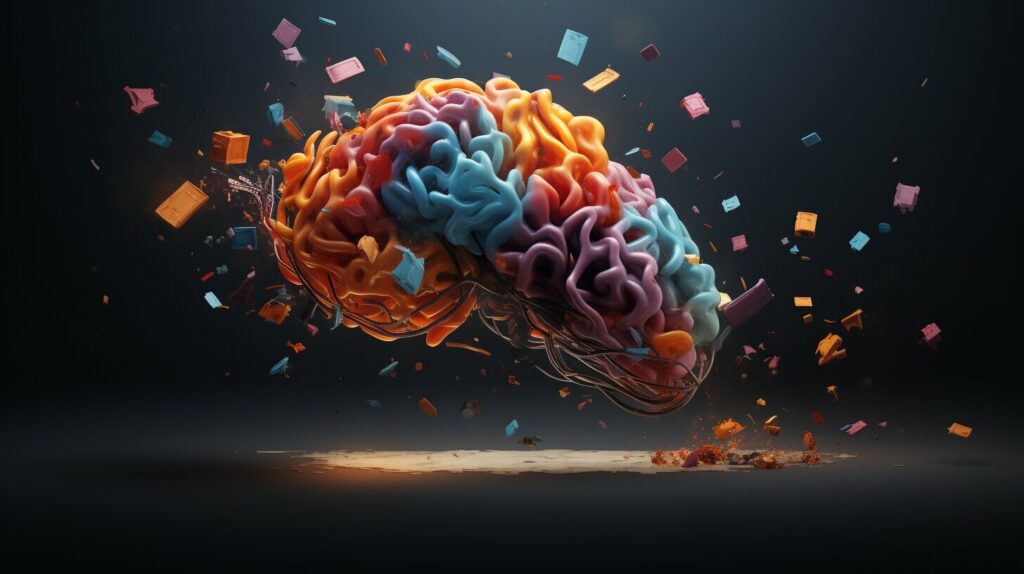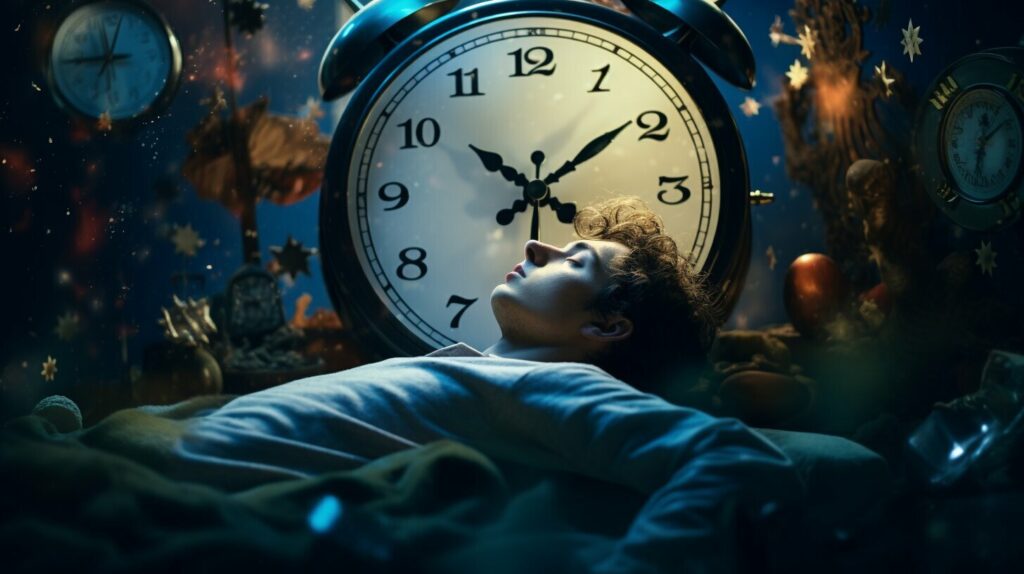Have you ever woken up from a short nap and vividly remembered a dream you had just moments ago? It’s a common experience, but it raises the question – can you actually dream 10 minutes after falling asleep?
The answer, as with most things related to sleep, is not straightforward. To understand the possibility of dreaming shortly after falling asleep, we need to explore the different stages of sleep and how they relate to dreaming.
Key Takeaways:
- Dreaming can occur shortly after falling asleep, but it’s most likely to happen during the Rapid Eye Movement (REM) stage of sleep, which usually occurs around 90 minutes after falling asleep.
- The sleep onset stage, which is the transition from wakefulness to sleep, can also include dreams.
- Factors such as sleep deprivation, medication, and individual differences can affect the frequency and vividness of dreams.
Understanding Sleep Cycles and Rapid Eye Movement (REM) Sleep
When we fall asleep, our brains go through various stages of sleep. These stages are divided into non-REM sleep and REM sleep. Non-REM sleep is further divided into three stages, while REM sleep comprises one stage.
The first stage of non-REM sleep is called the sleep onset stage. During this stage, we transition from wakefulness to sleep. This stage usually lasts for about 5-10 minutes. It is during this stage that dreams can occur, including dreams that happen shortly after falling asleep.
The second and third stages of non-REM sleep are the stages where we are in deep sleep. It is difficult to wake up during this stage. Dreams are less likely to occur during these stages.
REM sleep is the stage where we experience the most vivid dreams. It usually occurs around 90 minutes after falling asleep. It is called REM sleep because our eyes move rapidly during this stage. Our brain waves during REM sleep are similar to those when we are awake, which is why we are more likely to remember our dreams during this stage.
Research suggests that dreams are most likely to occur during REM sleep because our brains are more active during this stage. The brain is processing information from the day and consolidating it into our long-term memory.

It’s important to note that everyone’s sleep cycle is unique. Some people may experience more dreams during the early stages of sleep, whereas others may have more dreams during REM sleep. Factors such as sleep deprivation and medication can also affect the frequency and vividness of dreams.
Understanding Sleep Cycles and Rapid Eye Movement (REM) Sleep
Overall, understanding sleep cycles can help us better understand our dreams. By knowing when we are most likely to dream, we can improve our ability to recall dreams and gain insight into their potential meaning and significance.
The Sleep Onset Stage and Dreams
Have you ever drifted off to sleep and had a dream in the first few minutes of dozing off? This is known as the sleep onset stage, which is the transition from wakefulness to sleep. During this stage, the brain slows down and waves become longer.
It is possible to dream during the sleep onset stage, including dreams that happen shortly after falling asleep. These dreams tend to be less vivid and less memorable than dreams that occur during the later stages of sleep, but they can still provide insight into our subconscious thoughts and emotions.
The content of dreams during the sleep onset stage may be influenced by the events of the day or by our general mood and mental state. For example, if we watched a scary movie before bed, we may be more likely to have a dream with suspenseful or frightening elements.
It is important to note that dreams during the sleep onset stage are not the same as hypnagogic hallucinations, which are vivid sensory experiences that can occur as we fall asleep. Hypnagogic hallucinations are often accompanied by sleep paralysis, a temporary inability to move or speak that can be a frightening experience for some individuals.

While dreams during the sleep onset stage may be less significant than those that occur during REM sleep, they still play a role in our overall dreaming experience and can provide valuable insight into our subconscious thoughts and emotions.
The Role of Dreaming in the Early Sleep Cycle
As we’ve explored, dreams are most likely to occur during the REM stage of sleep, which typically happens around 90 minutes after falling asleep. However, it is possible to dream shortly after falling asleep during what is known as the sleep onset stage. This is the transition from wakefulness to sleep, where brain activity slows down and our muscles relax.
During this stage, we may experience what are known as hypnagogic hallucinations, which are vivid and often bizarre sensations that can be visual, auditory, or tactile. These experiences may include seeing patterns or faces, hearing voices or music, or feeling like we are floating or spinning. Although these hallucinations may seem like dreams, they typically occur in a state between waking and sleeping.
Some experts believe that these early sleep dreams may serve a different purpose than dreams that occur later in the sleep cycle. One theory suggests that they contribute to memory consolidation by processing and integrating new information from the day into our existing memory networks. Another theory proposes that they may help regulate our emotions by providing a safe space to process and release pent-up feelings.

It’s important to note that the content and frequency of dreams can vary greatly among individuals and may be influenced by factors such as medication, sleep deprivation, and personal experiences. However, by understanding the different stages of sleep and the potential role of dreaming in these stages, we can begin to unravel the mystery of our nighttime experiences and the impact they may have on our waking lives.
Factors That Influence Dream Frequency and Vividness
Dreams can be unpredictable, but there are certain factors that can influence how often we dream and how vivid those dreams can be.
One major factor is sleep deprivation. When we don’t get enough sleep, our brain tries to make up for it by increasing the amount of time we spend in REM sleep, which is when most dreaming occurs. This can result in more frequent and intense dreams.
Medications can also affect our dreams. Antidepressants and other psychiatric medications can cause vivid and unusual dreams, while certain sleep aids can inhibit dreaming altogether.
Individual differences also play a role. Some people simply dream more often than others, and some people have more vivid dreams. It’s possible that genetics or other biological factors may contribute to these differences.
| Factors that influence dream frequency and vividness: |
|---|
| Sleep deprivation |
| Medications |
| Individual differences |
It’s important to note that while these factors can affect our dreams, they don’t necessarily determine the content of our dreams. Personal experiences, emotions, and other psychological factors can all shape the dreams we have.
Next, we’ll explore the concept of lucid dreaming and how it can be used to experience dreams more consciously and intentionally.

The Importance of Dream Recall
As I discussed earlier, dreams can often hold significant meaning and provide insight into our subconscious. However, we can only benefit from our dreams if we are able to remember them. This is where dream recall comes in.
Dream recall refers to the ability to remember the details of our dreams upon waking up. For some, this comes naturally and they may remember their dreams vividly. For others, it may take some effort and practice to improve their dream recall. Regardless of where you fall on this spectrum, there are several techniques you can use to improve your dream recall.
One effective technique is keeping a dream journal. This involves writing down any details you remember from your dreams as soon as you wake up. By doing this consistently, you may start to notice patterns or recurring themes in your dreams, which can help you understand their meaning and significance.
Another technique is practicing relaxation exercises before bedtime. This can help calm the mind and make it easier to remember dreams upon waking up. Additionally, avoiding substances like alcohol and caffeine before bed can improve the clarity of your dreams and make them easier to remember.
Improving dream recall can enhance our understanding of our dreams and allow us to more fully integrate their messages into our waking lives. So, next time you wake up after a dream, take a few moments to jot down any details you remember – it may just lead to valuable insights and personal growth.

Exploring Lucid Dreaming
Have you ever had a dream where you realized you were dreaming and could control the outcome? This is called lucid dreaming, and it’s a fascinating phenomenon that has caught the attention of scientists and dream enthusiasts alike.
Lucid dreaming typically occurs during the REM stage of sleep, when the brain is highly active and dreams are most vivid. There are several techniques you can try to increase your chances of inducing a lucid dream, such as reality checks throughout the day and the Mnemonic Induction of Lucid Dreams (MILD) technique.
One of the potential benefits of lucid dreaming is the ability to confront and overcome fears or anxieties that may manifest in your dreams. Additionally, some people use lucid dreaming as a form of creative inspiration, as they can actively control the events and outcomes of their dreams.

It’s important to note that while lucid dreaming can be a fun and exciting experience, it’s not necessarily suitable for everyone. Those who struggle with anxiety or other mental health issues may find that lucid dreaming exacerbates their symptoms.
Whether you’re curious about lucid dreaming or a seasoned practitioner, it’s important to approach this practice with a sense of curiosity and openness. With the right techniques and mindset, lucid dreaming can be a rewarding and transformative experience.
Common Dream Themes and Interpretations
As discussed earlier, dreams can reveal a lot about our inner thoughts, emotions, and experiences. While dreams can take on many forms and themes, there are some common ones that many people experience.
| Dream Theme | Possible Interpretation |
|---|---|
| Falling | Often associated with feelings of insecurity or loss of control. |
| Being Chased | Can represent avoidance or the need to confront a problem or situation in waking life. |
| Flying | Sometimes seen as a symbol of freedom or escape from a stressful situation. |
| Teeth Falling Out | May symbolize concerns over communication or personal power. |
| Nakedness in Public | Can represent vulnerability or the fear of being judged by others. |
| Being Lost | May indicate feelings of confusion or uncertainty in one’s waking life. |
It’s important to keep in mind that dream symbolism can vary greatly depending on the individual’s personal experiences and emotions. While these interpretations can provide insights into common themes, it’s ultimately up to the dreamer to determine the significance of their dreams.
“Dreams are illustrations from the book your soul is writing about you.” – Marsha Norman
Interpreting dreams can be a helpful tool in understanding oneself and processing emotions. Keeping a dream journal and reflecting on the themes and emotions present in one’s dreams can be a valuable practice for personal growth and self-discovery.

The Conclusion: Can You Dream 10 Minutes After Falling Asleep?
After exploring the different stages of sleep and the role of dreaming in each stage, we can conclude that it is possible to dream shortly after falling asleep. While dreams are most likely to occur during the REM sleep stage, they can also happen during the sleep onset stage or even during the early stages of the sleep cycle.
Factors such as sleep deprivation, medication, and individual differences can also influence the frequency and vividness of dreams. Therefore, some people may be more likely to remember their dreams shortly after falling asleep than others.
Dreams are an essential part of our overall well-being, as they can help us process emotions and consolidate memories. Improving dream recall through techniques such as keeping a dream journal can also help us gain insight into our subconscious minds and potential meanings behind our dreams.
Moreover, lucid dreaming offers a unique opportunity to actively participate in our dreams and potentially influence their outcome. Exploring common dream themes and interpretations can also offer valuable insights into our personal experiences and emotions.
In conclusion, while the exact timing and frequency of dreaming may vary from person to person, it is indeed possible to dream shortly after falling asleep. Dreams offer a window into our subconscious minds and play an essential role in our overall mental and emotional well-being.
FAQ
Q: Can You Dream 10 Minutes After Falling Asleep?
A: Yes, it is possible to dream shortly after falling asleep. Dreams can occur during different stages of sleep, including the sleep onset stage and the early sleep cycle.
Q: Understanding Sleep Cycles and Rapid Eye Movement (REM) Sleep
A: Sleep consists of different stages, one of which is Rapid Eye Movement (REM) sleep. Dreams are most likely to occur during REM sleep, which usually happens around 90 minutes after falling asleep.
Q: The Sleep Onset Stage and Dreams
A: During the sleep onset stage, which is the transition from wakefulness to sleep, dreams can occur. This includes dreams that happen shortly after falling asleep.
Q: The Role of Dreaming in the Early Sleep Cycle
A: Dreaming in the early stages of sleep may serve various purposes, such as memory consolidation and emotional processing. Theories behind why we dream contribute to understanding the role of dreaming in the early sleep cycle.
Q: Factors That Influence Dream Frequency and Vividness
A: Various factors can affect the frequency and vividness of dreams, including sleep deprivation, medication, and individual differences. These factors may also impact the ability to dream shortly after falling asleep.
Q: The Importance of Dream Recall
A: Dream recall plays a significant role in understanding our dreams and their potential meaning. Techniques such as keeping a dream journal or practicing relaxation exercises can improve dream recall.
Q: Exploring Lucid Dreaming
A: Lucid dreaming is a state where the dreamer becomes aware that they are dreaming and can actively participate in the dream. Techniques for inducing lucid dreams and the potential benefits of this practice can be explored.
Q: Common Dream Themes and Interpretations
A: Dreams often revolve around common themes, and different interpretations can be attributed to them. The significance of personal experiences and emotions in dream content adds depth to their meanings.
Q: Conclusion
A: In summary, it is possible to dream shortly after falling asleep. Dreams can occur during various stages of sleep, and factors such as sleep cycles, dream recall, and individual differences can influence the frequency and vividness of dreams.






